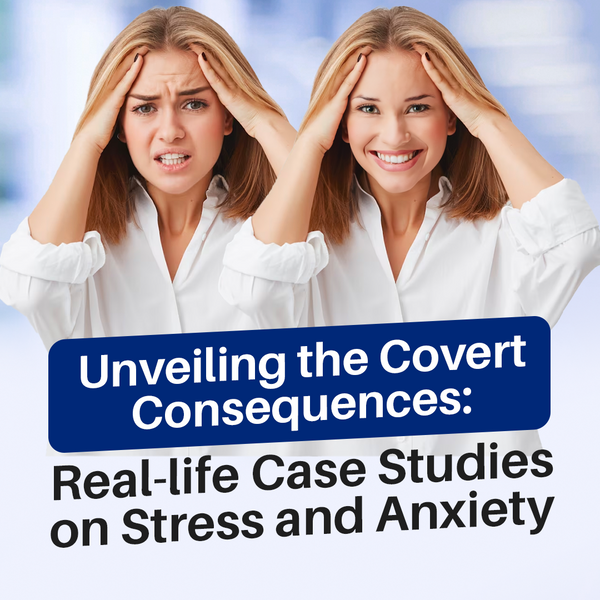In today's fast-paced world, stress and anxiety are part and parcel of everyday life. While they are natural reactions to challenging circumstances, persistent, poorly managed stress can result in serious health outcomes. The stress behind the development of these illnesses is often not seen or well-treated since it is invisible and doesn't show up on x-rays or lab tests.
Case Study 1: The Physical Toll of Chronic Stress and Anxiety
John, a middle-aged executive, experienced chronic stress due to work and family pressure, leading to a range of health issues. Having never learned good stress management skills, John overate, drank too much coffee in the daytime and alcohol in the evening, and made no time for exercise or relaxation in his overbusy days.
He didn’t complain or even recognize how stressed he was since all his colleagues and friends seemed to be dealing with the same issues. He didn't recognize the signs of stress but over a few years accumulated a number of medical diagnoses and medications to go with them.
- Eating on the run and too much coffee and alcohol gave him chronic heartburn, diagnosed as “GERD” (GastroEsophageal Reflux Disease) and treated with omeprazole and antacids
- John developed high blood pressure and high cholesterol, putting him at high risk for heart disease and stroke, so was given blood pressure medications and statin medication
- His increasingly poor sleep was treated with Trazodone, a medication that knocked him out but left him feeling groggy and starting his day with 2 or 3 large cups of coffee
- As he became increasingly exhausted and using more alcohol, he got crankier and more irritable, early signs of depression in men. His doctor started him on an antidepressant which helped his mood, but didn't help him change his lifestyle which was at the root of all these “diagnoses.”
Case Study 2: Mental and Emotional Consequences
Susan, a school teacher, faced constant anxiety due to high workload and financial problems. This prolonged exposure to unmanaged stress and anxiety led to:
- Emotional Burnout: Over time, Susan experienced emotional exhaustion leading to feelings of detachment, a condition often referred to as burnout.
- Cognitive Difficulties: Chronic stress and burnout affected her ability to concentrate, plan, and make good decisions.
- Depression: Eventually, persistent stress and anxiety triggered the onset of depression in Susan
Case Study 3: The Social Impact
Emma, a college student suffering from chronic stress, worry, and anxiety, exhibited changes in her social behavior:
- Isolation: She started withdrawing from her friends and social activities, leading to feelings of loneliness and even more stress.
- Conflict: Her stress made her irritable, leading to increased conflict in her personal relationships, worsening her isolation and loneliness.
Identifying these signs of too much stress is the first step towards recovery. None of these people had an illness or disease – they were overstressed and didn't have the tools or support to help them manage it. There are many techniques and tools that can help to keep stress and anxiety at manageable levels:
- Mindfulness and Meditation: Techniques like these helped John stay focused on the present moment, reducing his stress levels.
- Physical Activity: Regular exercise assisted Susan in reducing her stress. It served as a natural mood enhancer and distracted her from constant worry.
- Balanced Diet: Emma found that a healthy diet helped combat her stress. Certain foods even assisted in reducing stress, such as those rich in omega-3 fatty acids and vitamin C.
- Guided Imagery: Upon recognizing the detrimental effects of stress and anxiety on their daily lives, John, Susan, and Emma decided to learn how to reduce stress and manage it better when it couldn’t be avoided. Either on their own or with the urging of a therapist, they discovered relaxation and guided imagery. The skills and practices they learned became a keystone of their healthy lifestyle, playing a significant role in alleviating their stress and anxiety and guiding them towards recovery.
Recognizing the signs of excessive stress and anxiety is the first step towards effectively managing them. Learning good elf-care stress and anxiety reduction skills is the second step. If you’re too overwhelmed or mired down in the stress, professional help you dig out of it. Remember, seeking help and making strides towards a healthier life is absolutely okay. Living a life free from the burden of constant worry is your right. The journey to that life begins now.

